Below is a list of some brave men of PAF who fought for their country
courageously and brought glory to their service. Although it mentions PAF pilots
only but the successful engagements they had were made possible only by the
impressive team work of aeronautical engineers, radar controllers and other
ground crew.
This list is not complete and I have mentioned very few of the significant
historical events in PAF history that are associated with them. Note that the
officer ranks mentioned here were at the time of event.
(Late) Pilot Officer Rashid Minhas
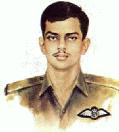 Pilot
Officer Rashid Minhas is the recipient of Nishan-i-Haider,
Pakistan's highest military award. Pilot
Officer Rashid Minhas is the recipient of Nishan-i-Haider,
Pakistan's highest military award.
On the morning of Friday, 20 August 71, Pilot Officer Rashid
Minhas aged 20, a pilot still under training, was in the front
seat of jet trainer, taxiing out for take off. An instructor
pilot from the same unit forced his way into the rear cockpit,
seized control of the aircraft and having taken off, headed the
aircraft towards India. With just 40 miles of Pakistan territory
remaining, Minhas had only one course open to him to prevent his
aircraft from entering India. Without hesitation and living up
to the highest traditions of the Pakistan Air Force, Rashid
Minhas tried to regain control of his aircraft, but finding this
to be impossible in the face of the superior skill and
experience of his instructor, forced the aircraft to crash at a
point 32 miles from the Indian border. In doing so, Pilot
Officer Rashid Minhas deliberately made the supreme sacrifice
for the honour of Pakistan and the service to which he belonged.
For this act of heroism above and beyond the call of duty, the
President of Pakistan awarded Nishan-i-Haider to Pilot Officer
Rashid Minhas. |
(Late) Sqn. Ldr. Sarfaraz Ahmed Rafiqui
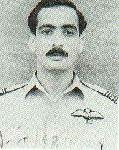 Sqn. Ldr. S. A. Rafiqui shot down 3 Indian planes (2 Vampires
and 1 Hunter) in the war of 1965.
Sqn. Ldr. S. A. Rafiqui shot down 3 Indian planes (2 Vampires
and 1 Hunter) in the war of 1965.
On 6th September, 1965, Squadron Leader Sarfaraz Ahmed Rafiqui
led a formation of three F-86 aircraft on a strike against
Halwara airfield. On the way back, the formation was intercepted
by about ten Hunter aircraft out of which Squadron Leader
Rafiqui accounted for one in the first few seconds. Soon after,
his guns jammed due to a defect and stopped firing upon which he
refused to leave the battle area and ordered his No. 2 to take
over as leader and continue the engagement with the enemy. In
the process, his aircraft was shot down and he was killed but
not without his action enabling his formation to shoot down
three more Hunter aircraft. Squadron Leader Rafiqui's conduct
was clearly beyond the call of duty and conformed to the highest
tradition of leadership and bravery in battle against
overwhelming odds. For this and his earlier exploits, he is
posthumously awarded Hilal-i-Juraat. |
Sqn. Ldr. Muhammad Mahmood Alam
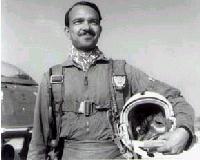 M. M. Alam is so far the top scorer fighter pilot of PAF. In the
war of 1965, he shot down 9 Indian planes (5 in one sortie) and
damaged another 2.
M. M. Alam is so far the top scorer fighter pilot of PAF. In the
war of 1965, he shot down 9 Indian planes (5 in one sortie) and
damaged another 2.
On 6th September, 1965, during an aerial combat over enemy
territory, Squadron Leader Mohammad Mahmood Alam in an F-86
Sabre Jet, shot down two enemy Hunter aircraft and damaged three
others. For the exceptional flying skill and valor displayed by
Squadron Leader Mohammad Mahmood Alam, he was awarded
Sitara-i-Juraat. On 7th September, 1965, Squadron Leader Alam
destroyed five more enemy Hunter aircrafts in less than a minute
, which remains a record till today. Overall he had nine kills
and two damages to his credit. For the exceptional flying skill
and valour shown by him in pressing home his attacks in aerial
combats with the enemy, Squadron Leader Mohammad Mahmood Alam is
awarded a bar to his Sitara-i-Juraat. |
Flt. Lt. Khalid Mehmood
 Flt.
Lt. Khalid Mehmood of No. 14 Squardon (PAF Minhas) shot down 3
Afghan fighters (2 MiG-23s and 1 Su-22) while flying in an F-16. Flt.
Lt. Khalid Mehmood of No. 14 Squardon (PAF Minhas) shot down 3
Afghan fighters (2 MiG-23s and 1 Su-22) while flying in an F-16.
His first kill was on September 12, 1988 when he with his No. 2
successfully engaged 6 MiG-23 aircraft of Afghan airforce on a
bombing mission inside the Pakistan territory and managed to
shot down 2 of them. His third kill came just after 3 weeks when
on November 03, 1988, he challenged a formation of 3 Afghan
Su-22s near Kohat and after a short dogfight, shot down one of
the planes. The entire incident was observed from the ground by
personnel of the Pakistan Army and by Phatan tribesmen. The
wreckage of the Afghan Su-22 fell 10 NM from Thal on the bank of
river Kurram. The picture on the left shows Flt. Lt. Khalid
being presented a Kalashinkov rifle by Maj. Gen. Ghazi-ud-din on
behalf of tribesmen. |
(Late) Sqn. Ldr. Abdul Hameed Qadri
 Sqn.
Ldr. Qadri of No. 9 Squardon (PAF Sargodha) shot down 2 Afghan
Su-22s on May 17, 1986. While on a CAP (Combat Air Patrol) with
his No. 2, he was directed by the radar controller to intercept
4 enemy planes violating Pakistani air space near Parachinar.
The pilots took the appropriate offensive position and after
visually identifying the targets, Sqn. Ldr. Qadri shot down 2 of
them, one with a AIM-9L sidewinder and the other with guns. He
did an outstanding job of engaging the targets, maintaining
excellent situation awareness, and remaining extremely cool in
trying conditions. The PAF awarded Sitara-i-Basalat to Squadron
Leader Hameen Qadri. He is seen in the picture on the left
beside the wing of SU-22. Sqn.
Ldr. Qadri of No. 9 Squardon (PAF Sargodha) shot down 2 Afghan
Su-22s on May 17, 1986. While on a CAP (Combat Air Patrol) with
his No. 2, he was directed by the radar controller to intercept
4 enemy planes violating Pakistani air space near Parachinar.
The pilots took the appropriate offensive position and after
visually identifying the targets, Sqn. Ldr. Qadri shot down 2 of
them, one with a AIM-9L sidewinder and the other with guns. He
did an outstanding job of engaging the targets, maintaining
excellent situation awareness, and remaining extremely cool in
trying conditions. The PAF awarded Sitara-i-Basalat to Squadron
Leader Hameen Qadri. He is seen in the picture on the left
beside the wing of SU-22.
Sqn. Ldr. Qadri also commanded the F-6 and F-7P squardons of CCS
(Combat Commanders School, PAF Sargodha) in 1993-94 and then
became Officer Commanding CCS.
PAF suffered yet another loss on July 20, 2002 when A. H.
Qadri (then Air Commodore and Base Commander PAF Minhas-Kamra)
died in an air crash while flying a F-7P aircraft. |
(Late) Wg. Cmdr. Abdul Razak
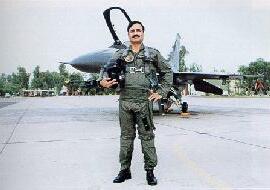 Wing
Commander Razak successfully intercepted and shot down an Afghan
AN-26 in 1987 near Miranshah. Wing
Commander Razak successfully intercepted and shot down an Afghan
AN-26 in 1987 near Miranshah.
On March 30, 1987, after taking off from PAF Minhas in an
F-16, Wing Commander Abdul Razzak and his No. 2, Squadron Leader
Sikander Hayat were vectored towards two slow speed intruders
that the controller visualized to be electronic intelligence (ELINT)
aircraft heading towards a radar position at Parachinar. He had
no hesitation in the existing wartime conditions, to permit the
F-16s to shoot down the military transport aircraft, which
though unarmed was violating Pakistan air space. After
identifying the one enemy plane as an AN-26 tranport plane, both
Wg. Cmdr. Razak and Sqn. Ldr. Hayat launched their heat-seeking
AIM-9 Sidewinder missiles. Both the two missiles connected and
the enemy aircraft crashed on snow-clad mountains below. He did
an outstanding job of remaining cool and skillful during the
intercept.
Tragically, A. Razaq (while at the rank of Air Vice Marshal)
died in a plane crash on February 20, 2003 near Kohat Air Base.
Other victims of the crash included the chief of air staff (Air
Chief Marshal Mushaf Ali Mir) and 15 other airforce officers.
|
Sqn. Ldr. Badar-ul-Islam
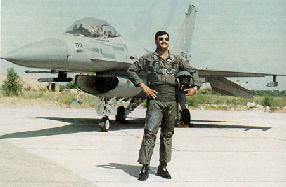 Sqn. Ldr. Badar shot down an Afghan Su-22 in 1987 while serving
with No. 14 Squardon (PAF Minhas). On April 16, 1987 he took-off
in an F-16 at 0630 hours with his No. 2 Sqn. Ldr. Pervaiz Murwat
and headed towards the CAP area near Thal. After three or four
orbits, the radar reported some activity well withen the
Pakistani border and vectored the formation towards the
intruders. The leader quickly got his No. 2 in shooter cover
position and the two headed west in full burners. The leader
picked up four blips on his radar scope , which was confirmed by
the radar controller. At a distance of about 7 NM, the leader
visually picked them up. Since it was early morning, with the
sun behind him, the leader could easily see all four shining
aircraft. He unleashed the Sidewinder missile at one of the
aircraft and in a couple of seconds, there was a big red flash
around the aircraft. It started to spiral towards the ground in
a left-hand turn. They then returned to base. After examining
all the evidence the PAF confirmed the kill.
Sqn. Ldr. Badar shot down an Afghan Su-22 in 1987 while serving
with No. 14 Squardon (PAF Minhas). On April 16, 1987 he took-off
in an F-16 at 0630 hours with his No. 2 Sqn. Ldr. Pervaiz Murwat
and headed towards the CAP area near Thal. After three or four
orbits, the radar reported some activity well withen the
Pakistani border and vectored the formation towards the
intruders. The leader quickly got his No. 2 in shooter cover
position and the two headed west in full burners. The leader
picked up four blips on his radar scope , which was confirmed by
the radar controller. At a distance of about 7 NM, the leader
visually picked them up. Since it was early morning, with the
sun behind him, the leader could easily see all four shining
aircraft. He unleashed the Sidewinder missile at one of the
aircraft and in a couple of seconds, there was a big red flash
around the aircraft. It started to spiral towards the ground in
a left-hand turn. They then returned to base. After examining
all the evidence the PAF confirmed the kill. |

 PAF
Heroes
PAF
Heroes